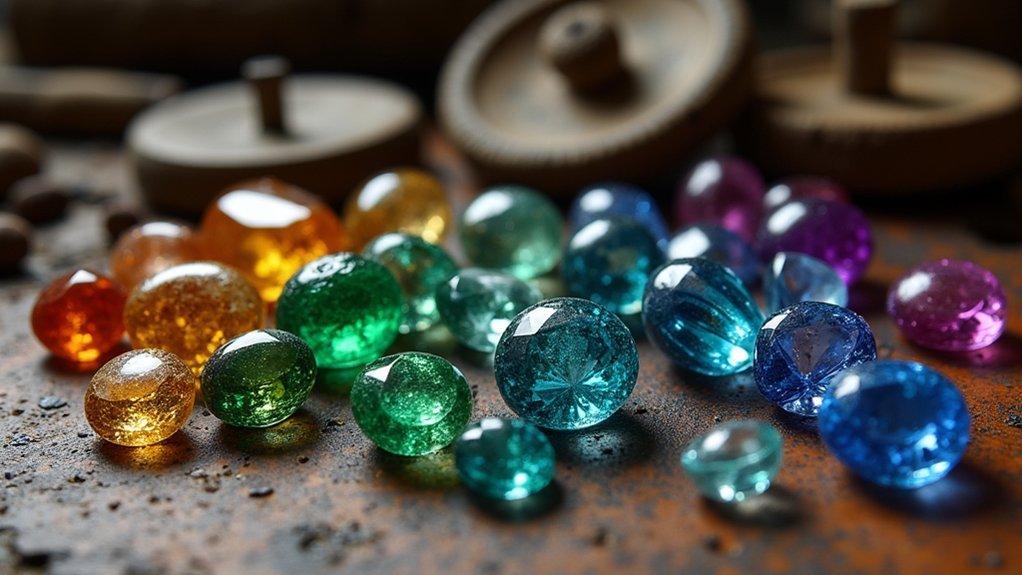Ancient gemstone cutting evolved from primitive stone tools to sophisticated artistry across civilizations. You’ll find Egyptians pioneered techniques with copper tools and abrasives, while Chinese masters perfected jade carving through successive dynasties. Mesopotamian artisans created intricate seals, Greeks introduced faceting, and Islamic craftsmen developed complex polyhedral cuts. The Renaissance saw diamond cutting revolutionized in Europe. These diverse traditions share a common thread of innovation that transformed ordinary stones into treasures of unparalleled brilliance.
Origins of Lapidary: From Stone Tools to Precious Gems

While primitive humans initially shaped stones for survival purposes, these rudimentary techniques gradually evolved into sophisticated lapidary arts.
You can trace this development from prehistoric times when early toolmakers discovered the principles of controlled breakage and relative hardness—fundamentals that would later define gem cutting practices.
Early Egyptian and Mesopotamian Cutting Techniques
You’ll find that Egyptian and Mesopotamian artisans revolutionized gemstone cutting through their innovative use of copper tools paired with sand and emery abrasives.
In Egypt, carnelian bead production exemplified their technical mastery, with craftsmen creating uniform, polished beads through drilling, grinding, and polishing sequences.
Royal lapidary workshops, particularly those serving Mesopotamian and Egyptian elites, became centers of innovation where specialized craftsmen developed and refined techniques that would influence gemstone cutting for millennia.
Copper Tools and Abrasives
Two ancient civilizations pioneered gemstone cutting through their metallurgical innovations: the Egyptians and Mesopotamians.
Around 3000 B.C., Egyptian lapidary techniques relied on copper tools—humanity’s first metal implements for shaping precious stones. They enhanced these tools’ effectiveness by incorporating abrasives like sand and emery to achieve smooth finishes on amulets and decorative pieces.
In Mesopotamia, artisans developed sophisticated cutting, drilling, and sawing methods using similar copper implements. Their intricate seals reveal remarkable gem-cutting skills that emerged from these basic technologies.
Both cultures mastered the art of controlled breakage and polishing, establishing fundamental lapidary techniques that would evolve over centuries. By the Sumerian period, craftspeople weren’t just cutting stones but also drilling and faceting them, setting the foundation for gemstone craftsmanship that would influence civilizations for millennia.
Carnelian Bead Production
Carnelian, a vibrant orange-red chalcedony, emerged as one of the earliest precious stones to be crafted into beads by both Egyptian and Mesopotamian artisans around 3000 B.C.
These ancient cultures valued carnelian for its aesthetic appeal and symbolic significance, developing sophisticated lapidary skills to transform the raw stone into prized ornaments.
You’ll find that craftsmen employed remarkably effective techniques, first shaping the carnelian against harder materials before polishing with abrasives like sand or emery to enhance its natural luster and translucence.
They created holes using bow drills—a precise method that allowed for perfect stringing in jewelry pieces.
The diverse cutting styles evident in archaeological findings showcase the advanced gemstone working traditions of these civilizations.
From simple spherical beads to more complex forms, carnelian work demonstrates how early lapidaries mastered sophisticated production methods using only primitive tools.
Royal Lapidary Workshops
The royal lapidary workshops of ancient Egypt and Mesopotamia represented the pinnacle of early gemstone craftsmanship, emerging as specialized centers of excellence by 3000 B.C.
These exclusive workshops served the nobility and priesthood, creating symbolic items that connected rulers to divine power.
You’ll find these ancient lapidary techniques remarkable for their sophistication:
- Craftsmen employed harder stones as tools to cut and drill softer gemstones.
- Mesopotamian artisans excelled in intricate seal carving using sawing methods.
- Egyptian lapidaries specialized in cabochon cutting for turquoise and carnelian.
- Both cultures developed advanced gem polishing using abrasive pastes.
The workshops’ output reflected each civilization’s aesthetic values while demonstrating an impressive understanding of stone hardness properties.
These specialized facilities guaranteed that the finest gemstone objects remained exclusive to those in positions of power.
The Jade Masters of Pre-Columbian America
You’ll find the jade carving techniques of Pre-Columbian civilizations remarkably sophisticated, with Olmec, Maya, and Aztec craftsmen developing specialized tools from obsidian and metal to create intricate ceremonial objects.
These master artisans shaped both jadeite and nephrite into masks, jewelry, and burial items that reflected their cultures’ deep spiritual connections to the stone.
Their nephrite tools weren’t just practical implements but carried profound symbolic weight, representing fertility, life forces, and connections to the underworld in Mesoamerican cosmology.
Ceremonial Carving Methods
Among ancient civilizations of the Americas, jade represented far more than mere decoration—it embodied divine power and cosmic significance.
Olmec, Maya, and Aztec artisans developed sophisticated ceremonial objects through meticulous craftsmanship that reflected their spiritual significance.
When you examine these ancient treasures, you’ll notice four distinctive carving methods:
- Stone-on-stone abrasion using harder materials to gradually shape the tough jade
- String-saw techniques with sand abrasives to create precise cuts and detailed contours
- Advanced polishing with fine materials like crushed hematite to achieve luminous finishes
- Symbolic incising patterns that connected the object to specific deities or cosmic forces
These techniques weren’t merely artistic—they imbued each piece with protective qualities and spiritual energy, transforming raw stone into powerful talismans for ceremonial use.
Symbolic Nephrite Tools
Within the sacred traditions of pre-Columbian America, nephrite jade emerged as perhaps the most revered material for symbolic tools and ceremonial objects.
You’ll find the Olmecs—Mesoamerica’s “mother culture”—pioneered sophisticated lapidary techniques as early as 1500 B.C., creating intricate nephrite tools that connected users to divine spheres.
The Maya civilization further refined these practices by 300 A.D., transforming nephrite into elaborate beads and decorative items through drilling and meticulous polishing.
These weren’t merely functional implements but powerful status symbols among the elite, requiring substantial resources and specialized expertise to produce.
Beyond their aesthetic value, nephrite ceremonial tools embodied concepts of power, fertility, and spirituality in pre-Columbian societies.
From ceremonial blades to figurines, each piece represented the intersection of artistry, belief, and social hierarchy.
Ancient Indian Gemstone Traditions and Innovations

India’s gemstone heritage stretches back to remarkable antiquity, with documented references to gem cutting appearing as early as 2300 B.C. when craftsmen used the term “manikyam” to describe beads and spherical gems.
Indian gem cutters developed sophisticated lapidary skills centuries before Europe, utilizing rudimentary faceting techniques to enhance gemstone brilliance.
India’s gemstone traditions truly flourished around 400 B.C. when Bapu Majajan advanced cutting methods for:
The ancient brilliance of India’s gem mastery emerged through Majajan’s innovations, transforming royal adornments and spiritual treasures alike.
- Rubies and sapphires for royal adornment
- Spinels and garnets crafted with spiritual significance
- Emeralds processed using specialized cabochon cutters
- Jade carvings displaying intricate craftsmanship
You’ll find that ancient Indian lapidaries understood both physical and metaphysical properties of gems, associating specific stones with planetary influences and healing attributes—creating a holistic approach to gemstone work that endures today.
Chinese Imperial Lapidary Practices Through Dynasties
Chinese Imperial lapidary traditions evolved from humble beginnings into one of history’s most sophisticated gemstone practices, with jade working as its crowning achievement.
You’ll find these techniques originated during the Shang dynasty, where artisans crafted ceremonial jade objects with reverence and precision.
During the Zhou period, carving methods advanced markedly through drilling and polishing techniques.
Han craftsmen later introduced improved tools, creating symbolic motifs in imperial burial items.
The Tang dynasty marked the pinnacle of lapidary innovation, with cutting techniques expanding beyond jade to include agate, turquoise, and coral.
Mediterranean Gem Cutting: Greek and Roman Contributions

While Eastern cultures focused on jade carving, Mediterranean civilizations revolutionized gemstone working through technical innovations that still influence modern lapidary.
The Greeks introduced faceting techniques that enhanced gemstones’ natural beauty beyond simple cabochon cuts, while Romans refined these methods further.
Four major Mediterranean gemstone innovations include:
- The introduction of the “table cut,” flattening a gemstone’s top surface to dramatically improve light reflection and brilliance
- Development of specialized tools like bow drills with diamond-tipped points for precise stone carving
- Creation of intaglios and cameos with intricate deity images and symbolic designs
- Establishment of systematic lapidary practices for working various gemstones including garnet, onyx, and amethyst
These techniques laid the foundation for European gem cutting traditions that would evolve into modern diamond faceting methods.
Islamic Golden Age Advancements in Faceting
As Europe emerged from the Dark Ages, Islamic artisans across the East were revolutionizing gemstone cutting through mathematical precision and artistic innovation.
In 11th century eastern Iran, lapidaries developed advanced polyhedral faceting techniques that transformed how precious stones were prepared and presented.
These sophisticated methods incorporated intricate geometric designs and precise angles that dramatically enhanced gemstones’ brilliance and visual appeal.
The Islamic Golden Age brought a fundamental shift from rudimentary cutting to complex faceting systems that showcased both technical mastery and artistic vision.
Detailed in numerous manuscripts, these innovations influenced contemporary practices and laid essential groundwork for European gemstone cutting techniques that would follow.
Islamic artisans’ contributions represented not just technical advancement but a complete reimagining of how gems could be transformed through human ingenuity.
Renaissance Europe’s Transformation of Diamond Cutting

During the Renaissance, European diamond cutting underwent a profound revolution that would forever change the gemstone industry.
By 1380, France had become one of the first European regions where true diamond cutting techniques developed. Louis de Berquen, later known as the Father of Modern Diamond Cutting, developed his lapidary skills to introduce absolute symmetry to gemstones.
The transformation included:
- Introduction of the rose cut, resembling an opening rose bud
- Implementation of early faceting methods that enhanced light reflection
- Refinement of polishing processes that revealed diamonds’ natural brilliance
- Adoption of techniques influenced by Islamic craftsmen’s 11th century innovations
These advancements relied heavily on technological innovation and secretive trade practices, with master craftsmen passing knowledge through apprenticeships rather than documentation.
Tools and Materials: The Evolution of Lapidary Equipment
The mastery of gemstone cutting during the Renaissance couldn’t have flourished without the continuous evolution of lapidary equipment that made such artistry possible.
Before Lodewyk van Bercken’s revolutionary horizontal diamond wheel in 1476, early artisans used primitive stone hammers to cut gems as domed cabochons, lacking the precision we admire today.
The crude tooling of early gem cutters yielded only rounded forms, a far cry from today’s geometric precision.
Lapidary manuscripts from the 18th century, like the 1728 Dictionary of Arts and Sciences, document significant advances—particularly the application of diamond dust on copper laps for superior polishing.
This technique transformed the polishing wheel into an efficient tool for achieving brilliant finishes.
The traditional water-powered polishing mill of Idar-Oberstein persisted alongside modern innovations, while GE’s 20th-century introduction of synthetic diamond powders marked the final leap from ancient techniques to industrial precision.
Frequently Asked Questions
How Did They Cut Gems in Ancient Times?
You’d find ancient gem cutters used drilling, sawing, and polishing techniques. They’d work with primitive tools for controlled breakage and abrasion, eventually developing faceting methods to enhance a stone’s brilliance and color.
How Did Romans Cut Gems?
Romans cut gems using bow drills, abrasive powders, and polishing techniques. You’ll find they favored cabochon cuts for garnets and amethysts, while also developing early faceting methods like the table cut for enhanced brilliance.
What Is the Difference Between Lapidary and Gem Cutting?
Lapidary is the broader craft of working with all stones, while gem cutting specifically focuses on faceting gemstones. You’ll find lapidary includes multiple techniques like cabochon cutting, whereas gem cutting emphasizes precision faceting for brilliance.
When Did Gem Faceting Begin?
Gem faceting began in the 14th century, though you’ll find earlier polyhedral faceting in 11th century Islamic cultures. You can trace modern faceting techniques to the late 1400s when improved grinding wheels revolutionized the craft.
In Summary
You’ve now journeyed across millennia and continents, witnessing humanity’s remarkable quest to capture light in stone. Whether through Egyptian bow drills, Chinese jade carving, or Renaissance diamond faceting, you’ll notice each culture developed unique solutions using available resources. As you consider these ancient techniques, you’ll appreciate how they’ve built upon one another, creating the foundation for today’s precision lapidary arts.





Leave a Reply